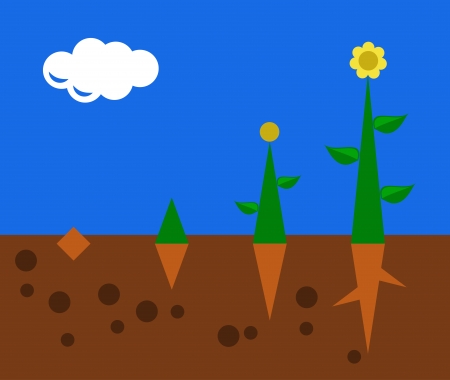1. Identifying Poor Drainage and Soil Compaction
If your backyard feels soggy, water stays around for days after rain, or your plants just aren’t thriving, you might be dealing with poor drainage or compacted soil. These issues can cause major headaches for gardeners and homeowners alike. Knowing what to look for is the first step toward fixing the problem.
Common Signs of Poor Drainage
When soil cant drain properly, water gets trapped on the surface or just below it. This can lead to a host of problems, from root rot to mosquito breeding grounds. Here are some common signs:
| Sign | Description |
|---|---|
| Pooling Water | Puddles that linger for hours or even days after rain are a clear sign of drainage issues. |
| Squishy Lawn | A lawn that feels spongy or squishy when you walk across it often has too much moisture trapped underneath. |
| Moss Growth | Moss thrives in damp, poorly drained areas and may indicate consistently wet soil conditions. |
How to Spot Soil Compaction
Soil compaction happens when soil particles are pressed tightly together, reducing pore space and making it hard for air, water, and roots to move through. This is especially common in yards with heavy foot traffic or clay-heavy soils.
| Indicator | What to Look For |
|---|---|
| Stunted Plant Growth | Plants may appear smaller than normal or grow slowly due to restricted root development. |
| Hard Soil Surface | If its tough to dig into your soil with a shovel or garden fork, it could be compacted. |
| Poor Water Absorption | Water runs off instead of soaking in during watering or rainstorms. |
Simple Test You Can Try at Home
Grab a screwdriver and try pushing it into your lawn or garden soil. If it’s hard to get more than a couple inches deep without using force, your soil is likely compacted. This easy test gives you a quick idea of what youre working with before moving on to solutions.
Why It Matters
Recognizing these signs early helps prevent long-term damage to your landscaping and plants. Once you know whether youre dealing with poor drainage, compaction, or both, you can start planning the right fix for your yard.
Stay tuned for Part 2 where we’ll explore practical solutions to improve backyard drainage and relieve compacted soil.
Improving Soil Structure with Organic Matter
If your backyard soil feels heavy, sticky when wet, or hard like a brick when dry, chances are youre dealing with compacted or poorly draining soil. One of the most effective and natural ways to improve this is by adding organic matter. This helps break up dense soil particles, allowing water to flow more freely and roots to grow better.
Why Organic Matter Works
Organic materials like compost, leaf mold, and well-rotted manure act like tiny sponges. They hold moisture where plants need it but also create air pockets that help excess water drain away. These materials also feed beneficial microbes that keep your soil healthy and active.
Best Types of Organic Matter
| Organic Material | Benefits | How to Use |
|---|---|---|
| Compost | Improves structure, adds nutrients, retains moisture | Mix 2-3 inches into top 6 inches of soil |
| Leaf Mold | Increases drainage and water retention, lightweight | Spread 1-2 inches over soil; mix lightly or use as mulch |
| Aged Manure | Nutrient-rich, boosts microbial activity | Add 1 inch and work into soil; avoid fresh manure |
| Coconut Coir or Peat Moss | Lightens heavy soils, holds moisture evenly | Use in combination with compost for best results |
When and How Often to Add Organic Matter
The best time to add organic matter is in the spring or fall when youre not actively planting. For long-term improvement, make it a habit to add organic material once or twice a year. Over time, youll notice softer soil, better drainage, and healthier plants.
Quick Tips:
- Avoid walking on wet soil—it compacts even more.
- Create a compost pile from kitchen scraps and yard waste.
- Mulch with shredded leaves during fall to slowly improve soil over winter.
- Test your soil every couple of years to track improvement.
Did You Know?
Just one inch of compost spread over 1,000 square feet can take up to four cubic yards of waste out of the landfill—and give you better garden soil at the same time!
Adding organic matter isn’t just about fixing soggy or compacted spots—it’s about building a foundation for long-term gardening success.
![]()
3. Installing Drainage Solutions
If your backyard stays soggy after rain or feels hard and compacted, its time to consider some drainage solutions. Poor drainage not only damages your lawn and plants but can also lead to foundation issues over time. Here are a few practical and homeowner-friendly methods to help redirect water and improve your soils health.
French Drains
A French drain is one of the most effective ways to manage standing water. It involves digging a trench, adding gravel, and placing a perforated pipe that redirects water away from problem areas.
How it Works:
- Water flows into the trench through the gravel
- The perforated pipe carries the water away from your yard
- The trench is covered back with soil or decorative stones
Best For:
Areas where water collects regularly, especially around foundations or in low-lying parts of the yard.
Dry Wells
Dry wells are underground structures that collect and slowly disperse excess water into the ground. They’re useful when you want to prevent water from pooling on the surface.
Main Components:
- An excavated pit lined with landscape fabric
- A large container or dry well unit filled with gravel or rocks
- Pipes directing water from gutters or drains into the well
Best For:
Diversions from downspouts, sump pumps, or French drains where stormwater needs a place to go.
Grading Techniques
If your yard is flat or slopes toward your home, regrading may be necessary. This means reshaping the land’s surface so water naturally flows away instead of settling.
Tips for Effective Grading:
- Create a gentle slope (at least 1 inch per foot for the first 6–10 feet away from structures)
- Avoid creating dips where water can pool again
- You may need fill dirt to build up low spots
Best For:
Larger yards with uneven terrain or drainage problems near patios, driveways, and homes.
Comparison of Backyard Drainage Options
| Drainage Solution | Best Use Case | Ease of Installation |
|---|---|---|
| French Drain | Standing water in low spots or near foundations | Moderate – Requires digging and pipe installation |
| Dry Well | Redirecting runoff from gutters or sump pumps | Moderate – Involves excavation and gravel fill |
| Grading | Poor slope causing water to move toward house | Advanced – May require professional help for large areas |
No matter which method you choose, improving backyard drainage helps protect your home’s structure, keeps your lawn healthy, and reduces muddy messes after every rainfall. Start small with one area at a time and expand as needed!
4. Planting for Better Drainage
One natural and effective way to improve drainage in your backyard is by choosing the right plants. Certain types of vegetation can thrive in wet or compacted soil, while also helping to break up dense soil and absorb excess moisture over time. This makes them a great long-term solution for areas with poor drainage.
Why Native and Water-Tolerant Plants Matter
Native plants are adapted to your local climate and soil conditions, which means they typically require less maintenance and water once established. When dealing with soggy or compacted soil, adding water-tolerant plants can help draw moisture from the ground and slowly improve the structure of your soil through their root systems.
Top Plants for Wet or Compacted Soil
Here are some popular native and water-tolerant plants that work well in many parts of the U.S. Check with your local extension office or garden center to find species best suited for your region:
| Plant Name | Type | Benefits | Recommended Regions |
|---|---|---|---|
| Swamp Milkweed (Asclepias incarnata) | Perennial Flower | Attracts pollinators, tolerates wet soil | Northeast, Midwest |
| Blue Flag Iris (Iris versicolor) | Perennial Flower | Adds color, thrives in wet areas | Northern U.S., Great Lakes |
| Buttonbush (Cephalanthus occidentalis) | Shrub | Improves soil, provides habitat for birds | Southeast, Midwest |
| Joe Pye Weed (Eutrochium purpureum) | Tall Perennial Flower | Tolerates wet soil, attracts butterflies | Northeast, Midwest |
| Sedges (Carex spp.) | Grass-like Plant | Reduces erosion, adapts to moist soils | Nationwide (species vary) |
Planting Tips to Improve Drainage Over Time
- Avoid overcrowding: Give plants enough space so air and water can move freely through the soil.
- Add organic matter: Mix compost into planting areas to help roots grow deeper and break up compacted layers.
- Diversify plantings: Combine deep-rooted perennials with shallow-rooted ground covers to enhance overall soil structure.
- Create rain gardens: Use low-lying spots in your yard to plant water-loving species that manage runoff naturally.
The right combination of native and water-tolerant plants not only beautifies your landscape but also plays a key role in managing moisture and improving drainage over time.
5. Preventing Future Drainage Issues
Once youve addressed the current drainage problems in your backyard, its important to take steps to prevent them from happening again. Maintaining healthy soil and proper water flow isnt a one-time fix—it’s an ongoing process that includes aeration, mulching, and smart watering habits.
Aerate Your Soil Regularly
Compacted soil is one of the biggest reasons water cant drain properly. Aerating your yard helps loosen the soil, allowing air, water, and nutrients to reach plant roots more effectively. You can use a manual lawn aerator or rent a machine for larger areas. Aim to aerate once or twice a year, especially if your yard sees heavy foot traffic or gets soggy after rain.
Use Mulch Wisely
Mulch isn’t just good for keeping weeds down—it also plays a big role in water management. Organic mulches like wood chips or shredded bark help the soil retain moisture while also improving drainage by breaking down over time and enhancing soil structure.
Benefits of Mulching
| Type of Mulch | Drainage Benefit |
|---|---|
| Wood Chips | Add organic matter and improve soil texture |
| Pine Bark | Allows better water infiltration while reducing compaction |
| Compost | Nourishes the soil and enhances microbial activity |
Adjust Your Irrigation Practices
If youre using sprinklers or any automated irrigation system, make sure you’re not overwatering. Wet or compacted soil often comes from giving plants more water than they need. Water early in the morning to reduce evaporation and allow time for absorption before evening. Also, consider drip irrigation systems—they deliver water directly to the roots and help prevent surface saturation.
Irrigation Tips for Better Drainage
- Check sprinkler heads regularly to avoid pooling in low areas.
- Install rain sensors to prevent watering when it’s not needed.
- Create watering zones based on plant needs and sun exposure.
By focusing on these three simple strategies—aeration, mulching, and smarter watering—you’ll help keep your backyard soil healthy and well-drained for years to come.


